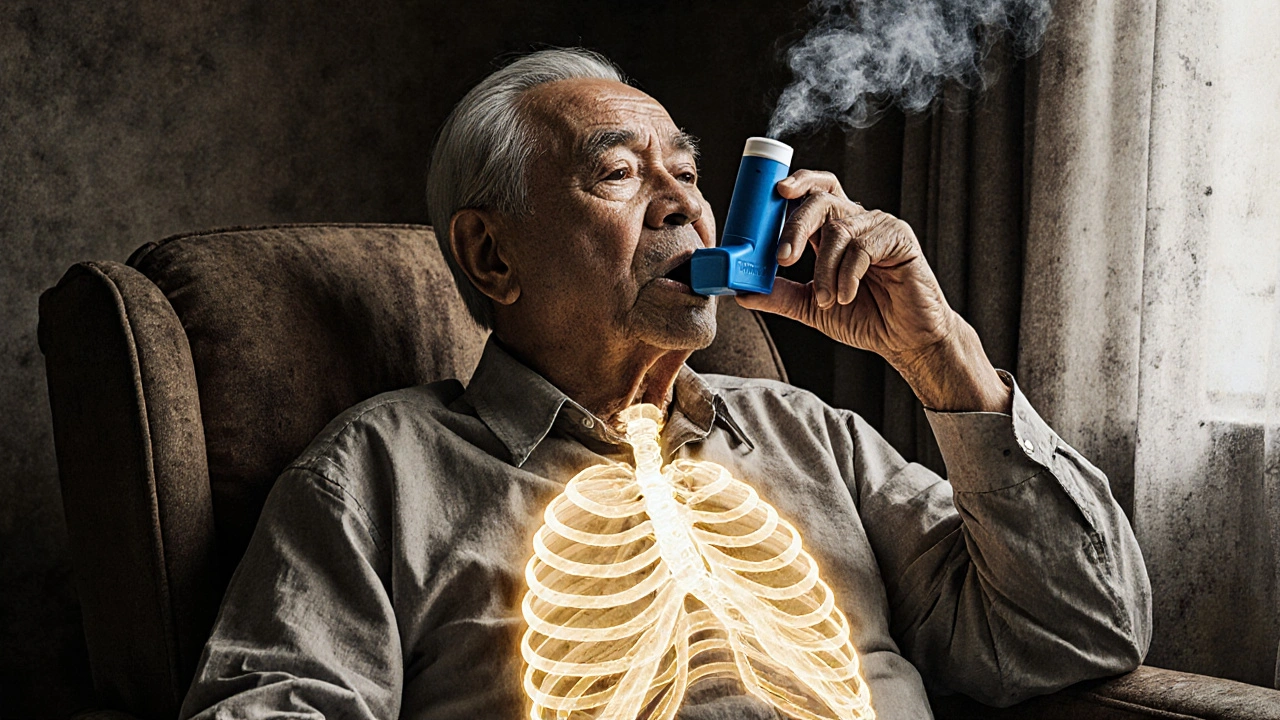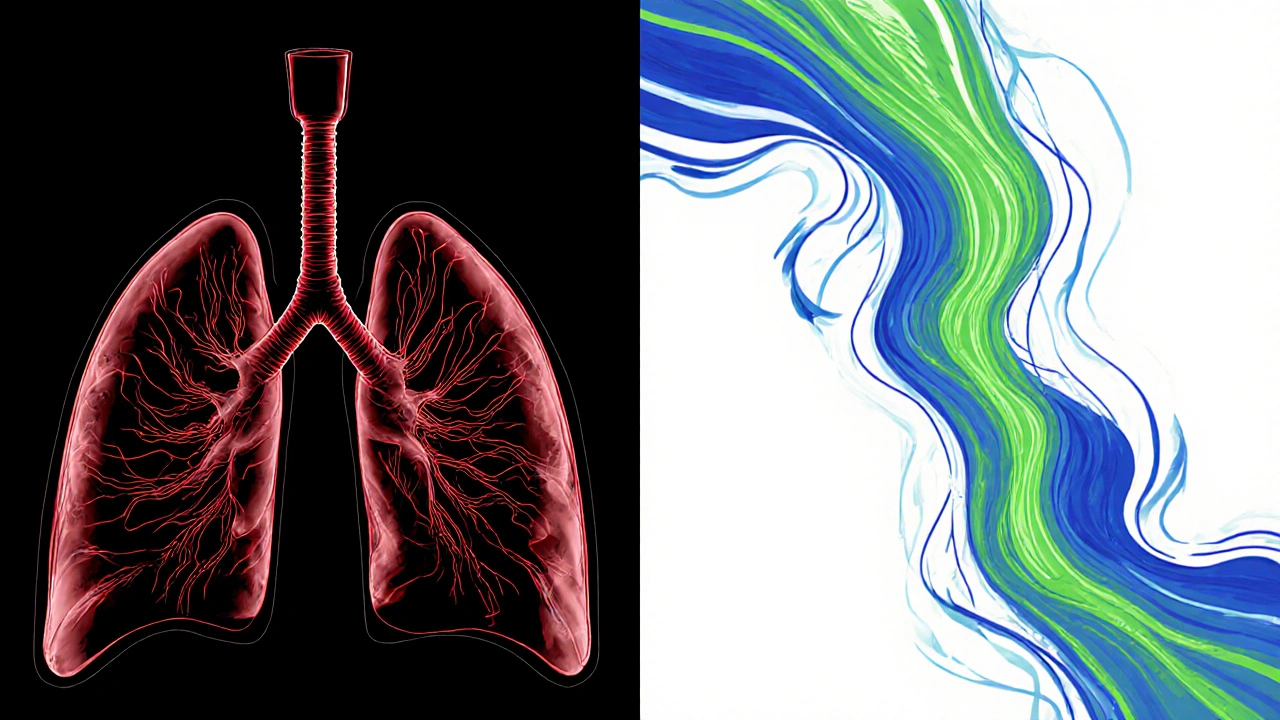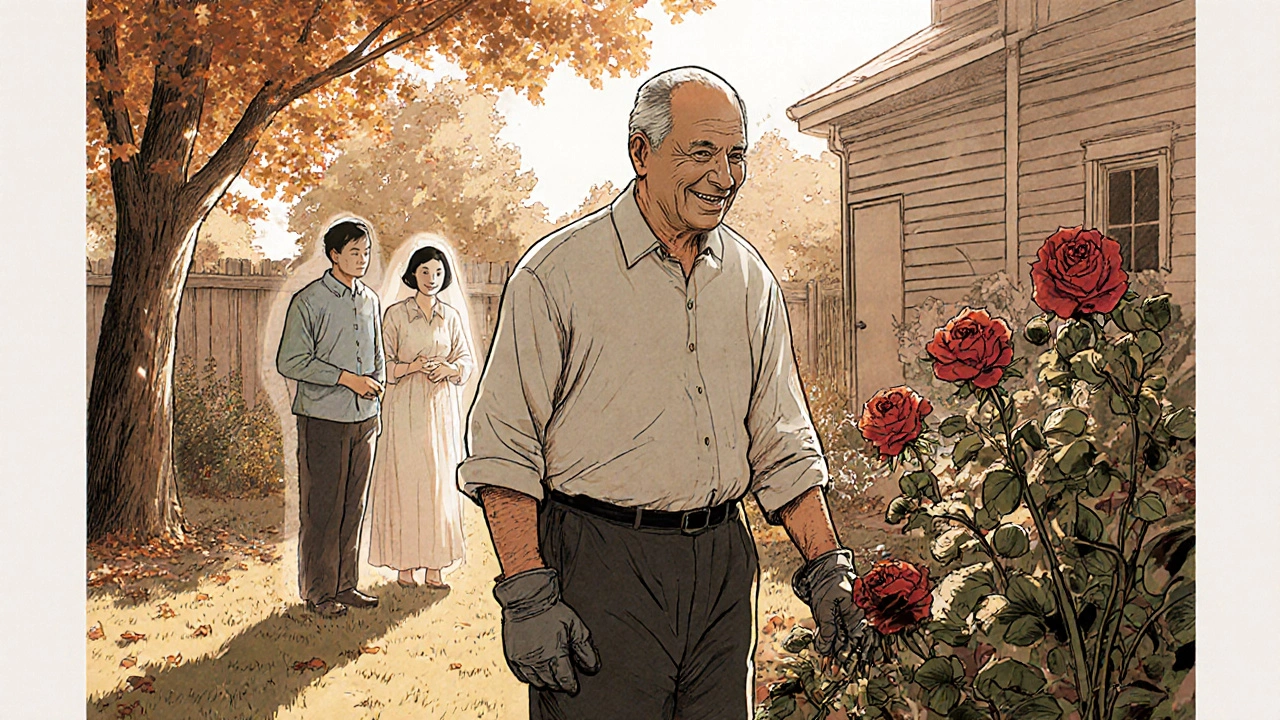Combining Ipratropium Bromide and Albuterol for Optimal Bronchodilation
 Oct, 27 2025
Oct, 27 2025
When your lungs feel tight, breathing becomes a chore. For people with COPD or chronic bronchitis, that daily struggle doesn’t go away with a single inhaler. But there’s a proven combo that works better than either drug alone: ipratropium bromide and albuterol. This pairing isn’t just common-it’s the gold standard for many patients who need more than a quick fix.
Why One Inhaler Isn’t Enough
Albuterol is a beta-agonist. It relaxes the smooth muscles around your airways, helping them open up fast. You feel it within minutes-your chest loosens, the wheeze fades. But its effect fades after 4 to 6 hours. And for some, especially older adults or those with severe COPD, albuterol alone doesn’t do enough.
Ipratropium bromide works differently. It’s an anticholinergic. It blocks the nerve signals that cause airway muscles to tighten. It doesn’t kick in as fast as albuterol-takes 15 to 30 minutes-but it lasts longer, up to 6 to 8 hours. It also reduces mucus production, which matters if you’re coughing up phlegm all day.
Used alone, each drug helps. But together? They hit the problem from two angles. One opens the airway muscle. The other stops it from clamping down again. That’s why doctors don’t just prescribe both-they often prescribe them in the same inhaler.
The Science Behind the Combo
Studies show this combination improves lung function more than either drug alone. One major trial published in the European Respiratory Journal found that patients using ipratropium bromide and albuterol together had a 25% greater improvement in FEV1 (how much air you can force out in one second) compared to those using albuterol only. That’s not a small gain-it’s the difference between needing oxygen at night and sleeping through it.
The combo also cuts down on flare-ups. In a 12-month study of over 1,200 COPD patients, those on the dual inhaler had 30% fewer hospital visits due to worsening symptoms. That’s not just about comfort. It’s about staying out of the ER, avoiding steroids, and keeping your life on track.
Why does this work so well? It’s called synergistic bronchodilation. The two drugs don’t just add up-they multiply. Albuterol stimulates receptors that relax muscle. Ipratropium blocks the ones that tighten it. You’re not just fighting one side of the problem-you’re taking control of both.
How It’s Prescribed
You won’t get this combo as two separate inhalers unless there’s a specific reason. Most often, it’s a single device: Combivent Respimat or Duoneb (nebulizer solution). The standard dose is two puffs of Combivent four times a day, or one nebulizer treatment every 6 hours as needed.
It’s not for sudden attacks. That’s what your rescue inhaler (like albuterol alone) is for. This combo is for maintenance-daily control. Think of it like brushing your teeth: you don’t wait until your gums bleed to do it. You do it every day to prevent the problem.
Some patients think, “If one puff helps, two must be better.” That’s not true. Overuse can lead to side effects like dry mouth, blurred vision, or even rapid heartbeat. Stick to the dose your doctor gives you. If you’re still struggling, talk to them. Don’t increase it yourself.

Who Benefits Most
This combo isn’t for everyone. It’s targeted. Best results come from people with:
- Chronic obstructive pulmonary disease (COPD), especially emphysema or chronic bronchitis
- Persistent symptoms despite using a short-acting beta-agonist alone
- Frequent exacerbations (flare-ups) requiring oral steroids or ER visits
- High mucus production with coughing
If you have asthma and your main issue is exercise-induced wheezing, this combo isn’t usually first-line. Albuterol alone or a steroid inhaler works better there. But if you have asthma-COPD overlap syndrome (ACOS)-which many older adults do-this combo becomes essential.
Age matters too. Older adults often have more cholinergic activity in their airways, making anticholinergics like ipratropium bromide especially helpful. It’s why this combo is so common in patients over 65.
Side Effects and What to Watch For
Most people tolerate this combo well. But side effects happen. Dry mouth is the most common-drink water, chew sugar-free gum. Blurred vision? Don’t drive right after using it. Urinary retention? Especially risky if you have an enlarged prostate. Talk to your doctor if you can’t pee after using your inhaler.
Less common but serious: fast heartbeat, chest pain, or worsening breathing. That’s rare, but if it happens, stop using it and get help. Ipratropium bromide can worsen glaucoma if it gets in your eyes. Always close your eyes when inhaling and rinse your mouth after.
It doesn’t interact badly with most meds, but if you’re on other anticholinergics (like some bladder or depression pills), you could get too much of it. Tell your pharmacist everything you take.
How to Use It Right
Using the inhaler wrong means you’re getting none of the benefit. Here’s how to do it properly:
- Shake the inhaler well before each puff.
- Breathe out fully-don’t breathe in while exhaling.
- Place mouthpiece tightly between lips.
- Press the canister and breathe in slowly and deeply for 3 to 5 seconds.
- Hold your breath for 10 seconds.
- Wait 30 seconds before the next puff.
- Rinse your mouth with water and spit it out.
For nebulizer users: Clean the device after every use. Don’t reuse the solution. Use fresh each time. A dirty nebulizer can harbor bacteria and make your lungs worse.

Alternatives and When to Consider Them
If this combo isn’t working, or side effects are too much, there are other options. Long-acting versions like tiotropium (Spiriva) or formoterol (Foradil) can replace ipratropium bromide and albuterol in daily regimens. But they’re not for quick relief.
Some patients switch to triple therapy: an anticholinergic + a long-acting beta-agonist + an inhaled steroid. That’s for more advanced COPD with frequent flare-ups. But it’s not a step up from this combo-it’s a different path.
Don’t rush to switch. Give the combo at least 4 to 6 weeks. It takes time to feel the full effect. Many patients think it’s not working because they don’t feel an instant rush. But it’s not about feeling high-it’s about breathing easier all day, every day.
Real-Life Impact
I’ve seen patients who couldn’t walk to the mailbox without stopping. After starting the combo, they’re walking the dog, gardening, playing with grandkids. One man in Dunedin, 72, told me: “I didn’t realize I’d forgotten what it felt like to breathe without thinking about it.”
This isn’t a cure. But for millions, it’s the difference between living with a disease and living with a manageable condition. It doesn’t fix lung damage. But it gives you back control.
If you’re on this combo, don’t stop it just because you feel better. COPD doesn’t go away. But with the right tools, you can keep it from taking more from you.
Can I use ipratropium bromide and albuterol together if I have asthma?
Yes, but only if you have asthma-COPD overlap syndrome (ACOS). For typical asthma, a low-dose steroid inhaler and albuterol are usually enough. Ipratropium bromide isn’t usually recommended unless your asthma is severe or poorly controlled with standard treatments. Always check with your doctor before combining.
How long does it take for the combo to start working?
Albuterol starts working in 5 to 15 minutes. Ipratropium bromide takes longer-15 to 30 minutes. The full effect of the combo usually kicks in within 45 minutes. You’ll feel relief, but it’s not instant like a fast-acting rescue inhaler. This is for daily control, not emergencies.
Is this combo safe for older adults?
Yes, it’s commonly used in older adults and often more effective for them. Ipratropium bromide helps with mucus and airway tightening, which are bigger issues in aging lungs. But older patients should watch for urinary retention, confusion, or dry mouth. Always start with the lowest dose and adjust slowly under medical supervision.
Can I use this combo every day, or only during flare-ups?
This combo is for daily maintenance, not rescue. Use it as prescribed-usually four times a day-even when you feel fine. Skipping doses lets your airways tighten again. Keep your rescue inhaler (like albuterol alone) for sudden symptoms. Never use the combo as your only rescue inhaler.
What happens if I miss a dose?
If you miss a dose, take it as soon as you remember-but only if it’s not close to your next scheduled dose. Never double up. If it’s almost time for your next puff, skip the missed one. Consistency matters more than perfect timing. Missing one dose won’t cause a flare-up, but missing several increases your risk.
Does this combo help with coughing and mucus?
Yes, especially the ipratropium bromide part. It reduces mucus production and helps clear airways by relaxing the muscles around them. Many patients notice less coughing and easier clearing of phlegm after a few days of regular use. It won’t dry up all mucus, but it makes it less thick and easier to manage.
Next Steps
If you’re on this combo, track your symptoms for two weeks. Use a simple journal: note how many times you use your rescue inhaler, if you wake up at night short of breath, or if you can walk farther without stopping. Bring it to your next appointment.
If you’re not on it yet but struggle with breathing, ask your doctor if this combo is right for you. Don’t assume you need a steroid inhaler first. For many, this dual approach is the most effective starting point.
Breathing should never be a daily battle. With the right tools, it doesn’t have to be.
sarat babu
October 27, 2025 AT 18:43This combo is literally a miracle worker!!! 🙌 I was wheezing like a broken accordion before I started this, and now I can walk my dog without stopping every 2 minutes!!! 😭❤️ Don't let anyone tell you it's not worth it - your lungs will thank you!!! 🏃♂️💨
Wiley William
October 28, 2025 AT 15:24Yeah right. Big Pharma pushed this combo because they own the patents and want you hooked. Albuterol alone works fine - they just want you buying two drugs instead of one. You think they care about your breathing? They care about your credit card. Check the FDA's 2018 whistleblower report - they knew about the inflated efficacy numbers. 🤫
Richard H. Martin
October 30, 2025 AT 02:19Let me tell you something, folks - this country used to make real medicine. Now we got some fancy imported chemical cocktail that’s barely better than breathing through a straw. I’ve seen veterans with COPD get better on old-school bronchodilators from the '80s - no fancy combos needed. This is just corporate greed dressed up as science. America first - medicine should be too!
Tim H
October 31, 2025 AT 10:51ok so i used this combo for like 3 weeks and my mouth was drier than a desert and i kept forgetting to rinse and then my vision got kinda blurry?? i thought i was going blind lmao. also i took 3 puffs once bc i was desperate and my heart felt like it was trying to escape my chest. not cool. maybe i’m just bad at this? also i think the nebulizer is a pain in the ass to clean lol
Umesh Sukhwani
November 1, 2025 AT 22:45While I appreciate the detailed scientific exposition, I must respectfully emphasize that the therapeutic efficacy of this combination must be evaluated within the context of individual physiological variation and cultural adherence to medical protocols. In many South Asian communities, patients often delay initiation due to misconceptions regarding pharmacological dependency - a concern that warrants compassionate, culturally nuanced counseling rather than purely clinical directives. The human element remains indispensable.
Vishnupriya Srivastava
November 2, 2025 AT 20:44Interesting how the post glosses over the fact that this combo increases the risk of urinary retention in men over 60 - which is a huge problem in elderly populations. I’ve seen three patients in my clinic alone who ended up with acute retention because they didn’t know the connection. This isn’t just about breathing - it’s about systemic risk. The post should’ve flagged this more prominently.
Matt Renner
November 4, 2025 AT 12:49As a pulmonologist with over 20 years of clinical experience, I can confirm that the synergistic bronchodilation effect is well-documented in the GOLD guidelines (2023 update). The 25% FEV1 improvement cited is consistent with meta-analyses from the Cochrane Database. However, I would add that adherence is the most significant limiting factor - many patients discontinue due to improper technique, not lack of efficacy. Proper inhaler training should be mandatory at every prescription.
Ramesh Deepan
November 4, 2025 AT 14:46I’ve been helping older patients in my community manage COPD for years, and this combo is a game-changer - but only if they’re taught how to use it right. One man I worked with thought shaking the inhaler meant shaking it like a soda can - he was getting zero medicine. Took us three visits to get him to breathe in slow and hold. Now he’s gardening again. It’s not magic. It’s consistency. And patience. And someone showing up to help you learn. That’s what really heals.